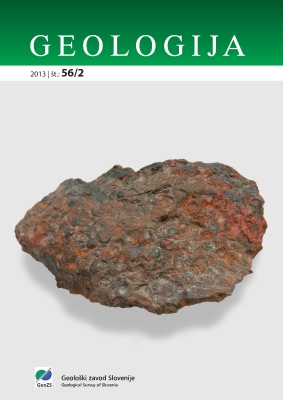Ladinian skonca beds of the Idrija Ore Deposit (W Slovenia)
DOI:
https://doi.org/10.5474/geologija.2013.010Abstract
The richly mineralised Skonca beds (der Lagerschiefer) were the most important mining level of the Idrija ore deposit. In addition to epigenetic ores, exceptional quantities of various rich syngenetic cinnabar ores could be found in these layers. »Jeklenka« (steel ore), »opekovka« (brick ore), »jetrenka« (liver ore), coral ore, and some other bedded cinnabar ores contained up to as much as 78 % Hg. These ores were excavated more or less intensively from their discovery in 1508 until the cessation of works in the Idrija Mine in 1977. The Skonca beds can be found in all parts of the Idrija ore deposit in the form of large or small, irregular, lense-shaped bodies or layers. In the section of the ore deposit known as 'Talnina', the Skonca beds are on average only 4 m thick, and from 10 to maximally 25 m in other parts of the ore deposit. The greatest thickness of these beds, i.e. around 40 m, can be found in the area of the Karoli tectonic unit, situated in the deepest part of the former Idrija Middle Triassic tectonic fault trough. The rocks in the Skonca beds are grouped in typical sequences, which represent a key for the reconstruction of sedimentary environments. The sequences are designated with the letters A, B, C and D. Sequence C is further divided into subsequences C1 with a carbonate and C2 with a siliceous structure. The lithological units of sequence A usually represent the lowest part of the Skonca beds, and may be the lateral equivalents of rocks of series B and subsequence C1. Sequence A is comprised of dispersed, gravelly varieties of carbonatic lythic sandstone, limestone and dolomite siltstone, as well as intercalations of gravelly silty micritic limestone and micritic limestone. Sequence B consists of typical transitional rocks between sequences A and C1, among which silty limestone with transitions to calcitic marlstone and claystone can be found. Sequence C is formed of 'classic' Skonca rock beds. Although the bottom part of sequence C has a carbonate structure (subsequence C1) and the top part has a siliceous structure (subsequence C2), the rocks cannot be distinguished from one another by their appearance. All are strongly bituminous and shaly. Sequence C is comprised of grey to black bituminous dolomite and quartz sandstone rich in pyrite and marcasite, dolomite or quartz siltstone, and shaly claystone with coal inclusions. The sequence of C rocks ends with clayey-lythic quartz sandstone containing remains of the brachiopod Discina. These are followed by various pyroclastic rocks of sequence D. The Skonca beds and the rich bedded cinnabar ores have various sedimentary structures which accurately define the events and environments of their origin. Except for the erosion Channels, which are filled with dolomite gravel, there are no other presedimentary structures in the Skonca beds (subsequence C1). However, the beds are rich in synsedimentary physical forms, particularly various stratifications, laminations and various forms of graded bedding. Among the postsedimentary structures, mention should be made of the abundant sinking and slump structures. In some places, bioturbation and the replacement of organic particles with pyrite can be observed. The Skonca beds were deposited in a spatially complex, marsh-lacustrine-lagoonal environment. The rocks of sequence A and partly also of sequence B were formed in an alkaline, oxygen-rich environment, and the lithological units of subsequence C1 in a reductive environment. The rapid transitions among rocks indicate strictly limited and slow lateral inflows of fresh water into the marshy environment overgrown with low vegetation. The rocks in subsequence C2 prove that the freshwater marsh was flooded with sea water. Deposited in the shallow, closed lagoon overgrown with low Vegetation were various bituminous shales, mudstones and sandstones filled with numerous radiolarians and needles of siliceous sponges and coal intercalations. The Sedimentation of the Skonca beds ends with quartz sandstone containing deposited remains of the brachiopod Discina. The Skonca beds cover a layer of various pyroclastic rocks that is up to 80 m thick.Downloads
How to Cite
Čar, J. (2013). Ladinian skonca beds of the Idrija Ore Deposit (W Slovenia). Geologija, 56(2), 151–174. https://doi.org/10.5474/geologija.2013.010
Issue
Section
Articles

